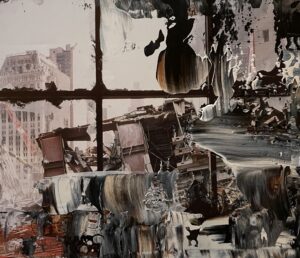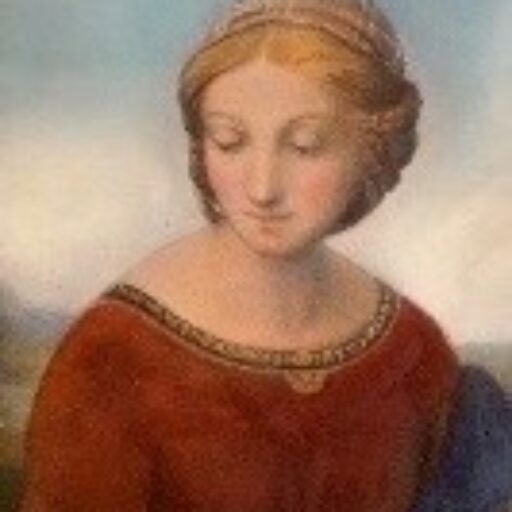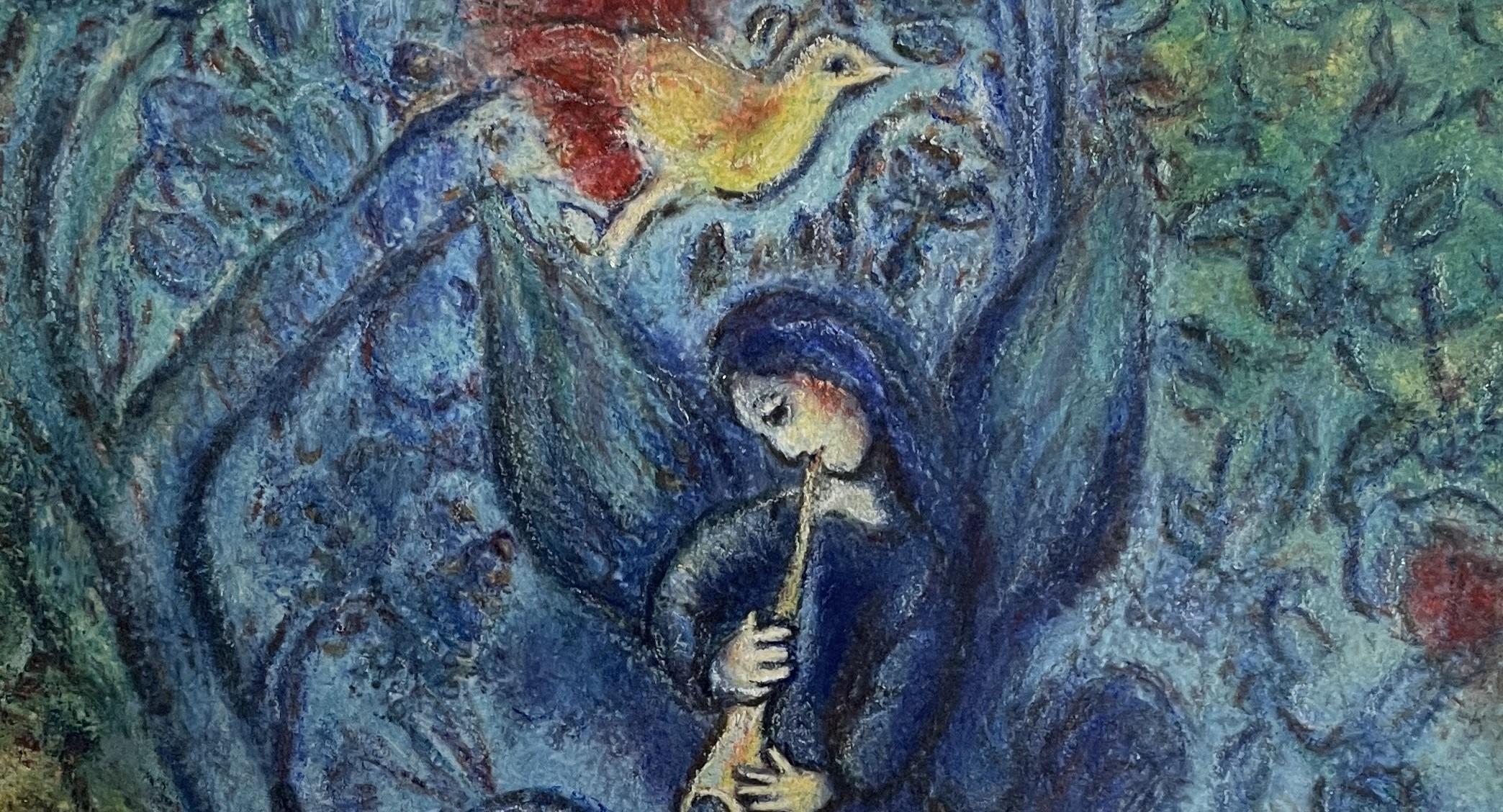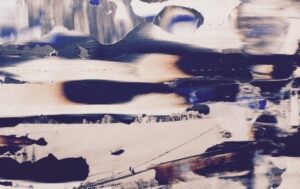日本語-Englishー台灣華語
ゲルハルト・リヒター「写真の上に描かれた抽象絵画」
ゲルハルト・リヒターの作品は政治的・哲学的思想を背景に語られることが多く、私にはその真意は図りかねるが、およそ絵画である以上、作品が放つ力や美に基づいて理解したい。私はリヒターのアブストラクト・ペインティングに強く惹かれる。
リヒターの作品は技法や作風が多岐にわたるため、一見統一性がないように見えるが、その中心にあるのは「より強い絵画をいかに実現するか」という普遍的テーマであると私は思う。その模索の中心に写真の絵画化がある。リヒターはまずフォト・ペインティングによって注目されるようになった。リヒターは写真をキャンバスに大きく描き写す。あえて全体の画面をぼかし、ぶれた写真のように描く。リヒターが並みの画家と異なるのは、「写真は最も完璧な絵画である」という認識から出発して絵画を制作している点にある。写真が登場して以来、現実の伝達手段として絵画の役割は終わった。肖像画に至っては写真に比較して精度が劣ることは明らかであると認めた上で、絵画の可能性を探っている。
これまで画家は、写真を制作上の参考とはしても、写真とは異なる境地や精神性を見つけだそうとしてきた。写真と対峙しそして苦悩して来た。しかしリヒターは写真と絵画の関係を正面からとらえ、むしろ写真自体を出発点としいることを明示して絵画を構築する。その潔さが、鋭く現代的な美しさを生みだしている。リヒターの絵画はモダンな部屋によく似合う。
フォト・ペインティングと抽象絵画の両方を体現したのが、リヒターの写真上に描かれた抽象絵画である。写真をキャンパスに描き写す手間暇をかけずに、直接写真に描き加え、一気に抽象化する。それは、いわばフォト・ペインティングと抽象絵画の両方を試すデッサンのようなものだ。私は豊かなリヒターの色彩抽象絵画を試みる前に、モノクロの風景写真を選び出し、空と大地を現わす青と茶の絵の具に、黒と白のモノクロ絵の具を加えた四色で試作してみることにする。フランスの穏やかな田園風景写真に、リヒターが加えたであろうように絵の具を無作為に、それでいて意図的に配置し、定規で一気に引き描く。描き直しを行うことはできない。するとそこには、実物のドキュメントとしての写真が一挙に抽象化され、絵としての新しい現実が与えられる。リヒターが称賛するジョン・ケージの偶然性が、イメージの強度を高める。偶然は現実を破壊しながら、同時に新たな現実を創り出し、完結することがない未知の美を紡ぎだす。

Abstract Painting on photograph(Kunii)
在照片上繪製的抽象畫
由國井正人以粉彩模仿繪製
Abstract Painting on photograph
Gerhard Richter’s works are often discussed against a backdrop of political and philosophical thought, a realm that I find difficult to fully grasp. However, as they are paintings, I wish to understand them based on the power and beauty they exude. I am particularly drawn to Richter’s abstract paintings. His oeuvre, characterized by a wide range of techniques and styles, may seem to lack unity at first glance. However, I believe at its core lies the universal theme of “how to realize a stronger painting.” Central to this exploration is the painting of photographs. Richter initially gained attention with his photo paintings. He enlarges photographs on canvas, deliberately blurring the entire image to mimic the appearance of an out-of-focus photo. Richter differs from ordinary painters in that he starts with the notion that “photography is the most perfect form of painting.” Since the advent of photography, painting’s role as a medium of reality transmission has ended. Recognizing that paintings are clearly inferior to photographs in terms of precision, especially portraits, he explores the possibilities of painting. Historically, painters have used photographs as a reference, yet they strived to find a different realm or spirituality. They have confronted and struggled with photography. However, Richter directly addresses the relationship between photography and painting, explicitly using photography as a starting point to construct his paintings. This candid approach generates a sharply contemporary beauty. Richter’s paintings suit modern rooms well.
Embodying both photo painting and abstract painting is Richter’s practice of directly adding to photographs on canvas, instantly abstracting them without the laborious process of painting the photo onto the canvas. It’s akin to a drawing exercise testing both photo painting and abstract painting. Before attempting Richter’s richly colored abstract paintings, I decide to start with a monochrome landscape photo, experimenting with a palette of blue and brown for the sky and earth, to which I add black and white monochrome paints. Like Richter might have done, I randomly yet deliberately place the paints on a gentle French pastoral landscape photo and draw across them with a ruler in one swift motion. There can be no redrawing. Suddenly, the photo as a document of reality is abstracted in one go, providing a new reality as a painting. The chance operations celebrated by John Cage, whom Richter admires, enhance the intensity of the image. Chance destroys reality while simultaneously creating a new one, weaving an endless beauty that never concludes.
格哈特·李希特「在照片上繪製的抽象畫」
蓋哈德·李希特的作品常常被賦予政治與哲學的思想背景,雖然我難以完全理解其深意,但作為畫作,我希望能基於作品散發的力量與美來理解它。我對李希特的抽象畫作深感吸引。李希特的作品因其技法和風格多樣,看似缺乏統一性,但我認為其核心是探索如何實現更強大的畫作這一普遍主題。這種探索的中心是對攝影的繪畫化。
李希特最初因其照片繪畫而受到關注。他將照片大幅度地複製到畫布上,故意模糊整個畫面,使其看起來像是模糊的照片。李希特與一般畫家不同的是,他從“照片是最完美的畫作”這一認識出發創作畫作。自從攝影出現以來,繪畫作為現實傳達手段的角色已經結束。他承認,相比於攝影,肖像畫在精確度上明顯較差,但仍在探索繪畫的可能性。過去,畫家即使將攝影作為創作參考,也試圖尋找與攝影不同的境界或精神性。與攝影對抗並經歷苦惱。然而,李希特正面對待攝影與繪畫的關係,明確將攝影作為出發點來構建畫作,這種純粹性產生了銳利且現代的美。李希特的畫作非常適合現代室內。
兼具照片繪畫與抽象畫的是李希特的“在照片上繪製的抽象畫”。他不費力地直接在照片上添加畫作,迅速抽象化。這既是一種探索照片繪畫與抽象畫的試驗。在嘗試豐富的李希特色彩抽象畫之前,我會選擇黑白的風景照片,並添加代表天空和大地的藍色與棕色,以及黑色與白色的單色畫料進行試作。就像李希特可能會在法國平和的田園風景照片上隨機而有意地布置顏料,並使用直尺快速畫出。一旦畫作完成,就無法重新繪製。如此,照片作為實物的記錄一下子被抽象化,賦予了畫作新的現實性。李希特讚美的約翰·蓋吉的偶然性,增強了圖像的強度。偶然性在破壞現實的同時,也創造出新的現實,編織出永不完結的未知之美。


